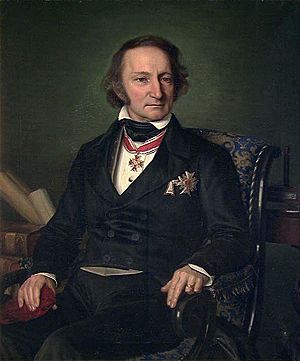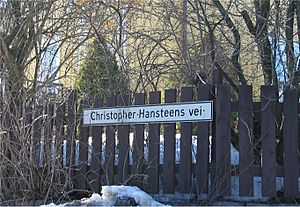Christopher Hansteen facts for kids
Quick facts for kids
Christopher Hansteen
|
|
|---|---|

Portrait by Aasta Hansteen
|
|
| Born | 26 November 1784 |
| Died | 11 April 1873 (aged 88) |
| Nationality | Norwegian |
| Alma mater | University of Copenhagen |
| Scientific career | |
| Fields | astronomy, mathematics, magnetism, mechanics |
| Institutions | Royal Frederick University (1814–1861) |
Christopher Hansteen (born 26 September 1784 – died 11 April 1873) was a famous Norwegian scientist. He was a geophysicist, astronomer, and physicist. He is best known for creating maps of Earth's magnetic field. This is the invisible force field that surrounds our planet.
Contents
Early Life and Education
Christopher Hansteen was born in Christiania, which is now Oslo, Norway. His father died when Christopher was young. He first went to Oslo Cathedral School from the age of nine.
In 1803, he started studying law at the University of Copenhagen. But he soon found that he liked mathematics more. He was also inspired by the lectures of a famous scientist named Hans Christian Ørsted. Hansteen became a mathematics teacher in 1806.
Becoming a Professor and Studying Magnetism
In 1807, Hansteen started to study terrestrial magnetism. This is the study of Earth's magnetic field. His first science paper was published in a journal after he won a contest in 1811.
In 1813, he received a special scholarship from the new Royal Frederick University in Christiania. He was promised a job there in the future. He moved to Norway in 1814 and became a lecturer.
By 1816, Hansteen was promoted to professor of astronomy and applied mathematics. He also became the editor of Norway's official almanac (a book with facts and dates for the year). He managed the city's astronomical observatory and helped lead the Norwegian Mapping Authority.
In 1819, he published a big book about Earth's magnetism. It was called Untersuchungen über den Magnetismus der Erde in German. He hoped his work would help scientists find the number and location of Earth's magnetic poles. In 1822, he helped start Norway's first science journal, Magazin for Naturvidenskaberne. He was its main editor for eight years.
Expeditions and Discoveries
To learn more about magnetism, Hansteen traveled a lot. He explored Finland and much of Norway. From 1828 to 1830, he went on a big trip to Western Siberia. He traveled with another scientist, Georg Adolf Erman, and had help from Russia.
He wrote a book about his journey called Reise-Erinnerungen aus Siberien. After he returned, in 1833, Hansteen and his family moved into the observatory. A special magnetic observatory was added in 1839.
Hansteen also wrote textbooks on geometry and mechanics between 1835 and 1838. His books were more focused on practical uses. He also wrote many other scientific papers for different journals.
He was a member of many important science groups in Norway and other countries. These included the Royal Norwegian Society of Sciences and Letters and the Norwegian Academy of Science and Letters.
Later Years and Legacy
Christopher Hansteen stopped giving lectures in 1856 because of his health. In 1861, he retired from his main work. But he kept studying and publishing papers on magnetism. He continued to edit the Norwegian almanac until 1863 and worked for the Norwegian Mapping Authority until 1872.
His daughter, Aasta Hansteen, became a well-known supporter of women's rights. Christopher Hansteen passed away in April 1873 in Christiania.
Awards and Recognition
Hansteen received many honors for his work. He was made a Commander of the Royal Norwegian Order of St. Olav in 1847. He received the Grand Cross of this order in 1855. He also received awards from other countries. A bust (a sculpture of his head and shoulders) was placed at his observatory in the 1850s.
Many things have been named after Christopher Hansteen to honor him:
- A crater called Hansteen and a mountain called Mons Hansteen on the Moon are named after him.
- In Oslo, a road called Christopher Hansteens vei is named after him.
- In Bergen, a street called Professor Hansteens gate was named after him in 1881.
See also
- Scandinavian Scientist Conference


